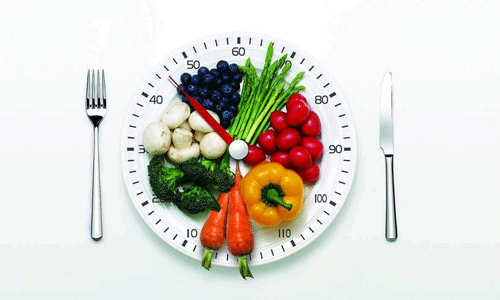关于减肥法和饮食法,你要pick哪个呢?
苗条,越来越成为现代人的刚需了。
钱包可以不饱,肉一定要少。
随之而来各种各样的减肥法和饮食法也越来越流行,而“间歇性节食”似乎是目前最流行的几种之一。
由于这种方法比较温和,在特定时间内还能毫无顾忌大吃大喝,不会把人折腾死,所以越来越多的人开始践行。
其中最主流的3种大概就是“5:2饮食法”、“隔日禁食法”和“限时进食”了。
但是,你真的确定这样减肥OK吗?这些减肥法的利弊你都清楚吗?

1. The 5:2 diet
5:2饮食法
This is a popular version of intermittent fasting where you eat a very low calorie diet (about 500kcal) for two days each week (any two days). On the other five days, you eat as normal.
这是一种很流行的间歇性禁食,你每周两天(任何两天)吃低热量饮食(约500kcal)。在其他五天,你正常吃。
Research has shown that it’s possible to lose weight with this diet; it also improves several markers of health, such as reducing levels of glucose and cholesterol in the blood.
研究表明,这种饮食可以减肥;它还能提高好几种健康指标,例如降低血液中葡萄糖和胆固醇的水平。
But the 5:2 diet is unlikely to be more effective for weight loss than traditional methods of dieting. This is because 5:2 reduces calorie intake to a similar extent as traditional dieting.
但与传统节食方法相比,5:2饮食法不太可能对减肥更有效太多。这是因为5:2减少的卡路里摄入量,与传统节食差不多。
There is some evidence that conducting the two days of very low calorie intake on consecutive days can improve insulin sensitivity - a risk marker for type 2 diabetes - to a greater extent than traditional dieting. This approach also leads to decreases in blood lipids (fatty substances found in the blood) compared with traditional dieting.
有证据表明,连续进行为期两天的低卡路里摄入可以提高胰岛素敏感性——这是2型糖尿病的风险标志物——而且幅度比传统节食更大。与传统节食相比,这种方法还导致血脂(血液中存在的脂肪物质)的减少。
An important extra benefit of 5:2 is that you can consume some food during the “fasting” period, providing an opportunity to take in vital nutrients.
5:2有一个重要的额外好处,那就是你可以在“禁食”期间也可以吃一些食物,以此摄取一些重要的营养。

Dieting often leads to losses in muscle and bone mass, alongside fat mass because consuming a balanced diet while reducing calorie intake is difficult.
节食常常导致肌肉和骨量的减少,以及脂肪量的减少,因为在减少卡路里摄入的同时保持饮食均衡是很困难的。
This can compromise long-term weight loss efforts as muscle is more metabolically active (burns more calories) than fat. Eating enough protein can help to reduce the loss of muscle mass while dieting, with a bonus of reducing appetite.
这可能会影响长期减肥的效果,因为肌肉比脂肪更具代谢活性(燃烧更多卡路里)。食用足够的蛋白质可以减轻节食期间的肌肉流失量,同时还能减少食欲。
2. Alternate-day fasting
隔日禁食法

While 5:2 could be considered a “lifestyle intervention”, alternate-day fasting (ADF) is more likely to be used to lose weight quickly.
5:2可以被视为一种“生活方式干预”,而隔日禁食(ADF)更有可能让你快速减肥。
ADF is often referred to as the “every other day diet” and requires you to alternate daily between unrestricted eating and consuming a very low calorie diet.
ADF通常被称为“隔日饮食”,并且要求您每天在不受限制的饮食和极低卡路里饮食之间交替使用。
Most research on ADF uses a similar approach to 5:2, allowing a small meal (usually about 500kcal) to be consumed on “fasting” days.
大多数关于ADF的研究使用的方法和5:2饮食差不多,允许在“禁食”日消耗少量食物(通常约500kcal)。
Research has shown that ADF can lead to considerable weight loss in 8-12 weeks, but a big problem with ADF is that adherence tends to wane. Longer-term studies have shown that calorie intake on “fasting” days creeps up over time, which reduces the calorie deficit achieved and slows the rate of weight loss.
研究表明,ADF可在8-12周内导致相当大的体重减轻,但ADF的一个大问题是:节食者坚持的能力越来越弱。长期研究表明,“禁食”日的卡路里摄入量会随着时间的推移而逐渐增加,因此卡路里缺口会变小,减肥的速度也会降低。
Randomised controlled trials (the gold standard of clinical research) show that ADF doesn’t lead to more weight loss or improvements in health compared with traditional dieting when calorie intake is the same in both groups.
单一对照试验(临床研究的黄金标准)表明,与传统节食相比,当两组的卡路里摄入量相同时,ADF不会导致更多的体重减轻或健康改善。
Despite this, it is likely that ADF will result in a greater reduction in calorie intake compared with traditional methods of dieting, which should lead to greater weight loss, initially. But it’s doubtful that many people will adhere to ADF in the long term.
尽管如此,与传统的节食方法相比,ADF确实能减少更多的卡路里,在初期会导致更大的体重减轻。但大部分人能不能坚持ADF,就值得怀疑了。
3. Time-restricted eating
限时进食

Time-restricted eating (TRE) involves complete fasting for long periods (16-20 hours) and consuming all calories within restricted hours, often referred to as “feeding windows”.
限时进食(TRE)是指长时间(16-20小时)完全禁食并在限制时间内消耗所有卡路里,通常称为“禁食窗口期”。
The most common version of TRE uses a ratio between fasting and eating of 16:8 (16 hours of fasting and eight hours during which it is permissible to eat). Many people achieve this ratio by skipping breakfast thereby delaying their first meal until midday and consuming all food between midday and 8 pm.
在最常见的TRE版本里,禁食和进食的比例为16:8(16小时禁食和8小时允许进食)。许多人通过不吃早餐来实现这一比例,将早餐延迟到中午,并在中午和晚上8点之间消费所有食物。
Research has shown that calorie intake over a 24-hour period is reduced when people skip breakfast. But the number of calories expended through physical activity is also reduced, which will partially or completely negate the calorie deficit achieved by skipping breakfast.
研究表明,当人们不吃早餐时,24小时内的卡路里摄入量会减少。但是通过体力活动消耗的卡路里数量也减少了,而这将部分或完全抵消不吃早餐导致的卡路里缺口。
So skipping breakfast is unlikely to lead to meaningful weight loss. Skipping breakfast also reduces the effectiveness of insulin to regulate blood glucose levels after lunch, indicating a negative effect on insulin sensitivity.
所以不吃早餐不太可能导致有效的减肥。不吃早餐也会降低午餐后胰岛素调节血糖水平的效果,这表明它对胰岛素敏感性有负面影响。
But an alternative approach to TRE has shown promise. A recent study found that fasting from 2 pm improved insulin sensitivity in a group of pre-diabetic males. This could be due to an enhanced natural ability to regulate blood glucose levels effectively in the morning, due to daily variations in metabolism.
最近的一项研究发现,从下午2点开始禁食改善了一组糖尿病前期男性的胰岛素敏感性。这可能是由于早晨调节血糖水平的天然能力增强,是因为新陈代谢的日常变化。
So, restricting food intake to a morning feeding window and fasting in the evening may be a healthier version of TRE.
因此,早上禁食、晚上节食可能才是更健康的TRE版本。
As with any diet, success will be dictated mostly by adherence. When it comes to weight loss, ADF is likely to lead to the most rapid success, but sustaining weight loss in the long term may be aided by the less intense 5:2 approach.
与任何饮食一样,成功主要取决于坚持。在减肥方面,ADF能最快带来效果,但长期的减肥可能需要靠强度稍弱的5:2来达到。
There is some evidence that adherence could be greater in TRE, as completely restricting food intake may be easier for some people than severely restricting it.
有一些证据表明TRE更容易坚持,因为完全限制食物摄入对某些人来说可能比严格限制食物更容易。
In this sense, research suggests that skipping dinner may be better for health than skipping breakfast.
从这个意义上讲,研究表明,跳过晚餐可能比跳过早餐更好。


